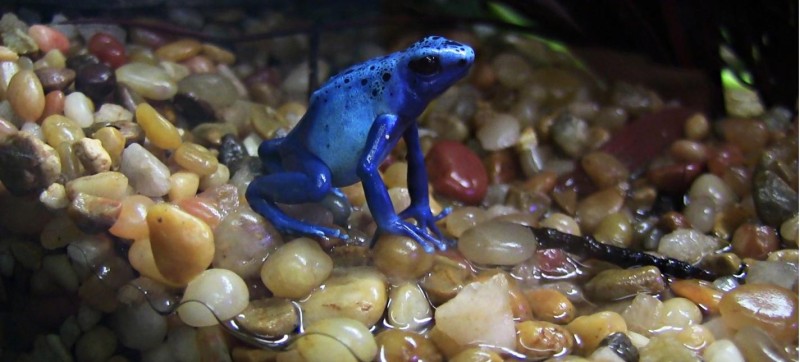Blue Poison Dart Frog - Dendrobates azureus

Habitat:
Rain forest floor near small streams or pools.
Range:
Central and South America
Activity Cycle:
Diurnal
Features:
This species usually have either a blue or green coloring, but can come in a variety of colors. Adults are about 4 cm long. As tadpoles they use gills to breath until they reach adulthood when lungs develop. Poison glands are located across the surface of their body.
Size:
1-2 inches
Social Structure:
Males establish territories and females join males
Life Expectancy:
6-10 years in captivity
Diet:
Very active during the day, they search for their food, which mostly consists of small invertebrates. The most important part of their diets is ants that have high levels of alkaloids in their bodies. The poison arrow frog uses these alkaloids to make the poison that is found in their skin. They can also use their long sticky tongue to catch their prey. They are incredibly tiny so they eat small things like ants, termites and small spiders.
Reproduction:
Male poison arrow frogs go through an elaborate mating ritual by which they work to attract a mate. Initially the males fight amongst themselves to establish their territory. The male, once having established his own territory for the mating season, attracts a female through a series of “trilling sounds.” Once mating is complete, dozens of eggs are enclosed in a gelatinous substance for protection. They will develop for two weeks while the male occasionally checks on them. When the tadpoles are hatched, they swim up on the males back, where they are attached a mucus secretion. They are then carried to a safe place where then can mature for a total of three months. The actual mating season can last throughout the rainy season from mid-July through mid-September.
Status:
Currently not at risk, but the blue poison arrow frog is considered to be vulnerable. Due to decreasing habitat they may both soon be put on the list of endangered species. The convention of International Trade lists this species as "Appendix II"
Interesting Facts:
- The poison arrow frog’s bright colors are used to warn predators of their poison. Predators usually recognize the bright color and avoid them.
- Poison arrow frogs are being used in research. Some compounds in their body, if harnessed correctly, may have the potential to lead to a new drug that would be up to 200 times more effective than morphine.
- Poison dart frogs, also called poison arrow frogs, are so named because some Amerindian tribes have used their secretions to poison their darts. Not all arrow frogs are deadly, and only three species are very dangerous to humans. The most deadly species to humans is the golden poison arrow frog (Phyllobates terribilis). Its poison, batrachotoxin, can kill many small animals or humans. These frogs are found in Colombia along the western slopes of the Andes. Arrow frogs are not poisonous in captivity. Scientists believe that these frogs gain their poison from a specific arthropod and other insects that they eat in the wild. These insects most likely acquire the poison from their plant diet.
- In 1999 a Zoo pathologist published his discovery of a then-mysterious infection that was afflicting and eventually killing poison arrow frogs and white’s tree frogs. Through his effort, cutaneous chytridiomycosis was documented for the first time as a vertebrate parasite. The veterinarians along with keepers and pathologists also developed a treatment for the chytrids. The same antifungal that is used to kill athletes’ foot in humans can be used with the frogs and toads.
- Mating-Male selects a flat area, which he cleans off and calls to females.
- 116 species of poison arrow frogs whose colors vary from green, red, pink or gold.
- Males can be distinguished from females by their larger front toe pads.
Prices
- Adult (13 and over)$12.50
- Child (2 - 12)$9.00
- Child (1 and Under)FREE
- Senior (65+)$11.50
- Active Military$11.50
We begin transferring animals to evening (off exhibit) holding at 4:30 each night.
Find Us
2320 N. Prospect Rd.
Peoria, IL 61603
Phone: 309-686-3365
Open Daily 10:00-5:00
Last admission at 4:30
